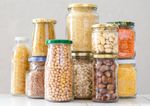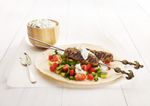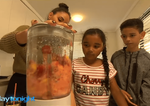Back to school
by Sarah Moore, Registered Nutritionist
- February 3, 2017
- Leave a comment
- Families
- Healthy eating
- Top Tips
- Shopping
- Fruit and Vegetables
- Back to School
- Smart Swaps
- Main Meal
- Drinks
- Nutrition Facts

You don’t need to spend hours in the kitchen to put together nutritious, balanced lunch boxes. Registered Nutritionist, Sarah Moore gives us the low-down on keeping mornings easy and giving the kids a lunch that keeps them going.
What to pack?
To avoid the apple that just keeps coming home, involve the kids in what goes into the lunchbox. At the supermarket, let them choose the fruit, vegetables and types of bread, wraps or rolls. You don’t need to give them free reign, but a choice between two types of bread can be the difference between a sandwich that gets eaten and one that comes home again.
Keep it simple!
Keep things simple by using fresh nutritious foods that you have at home. You don’t need to buy special food for lunchboxes. A traditional sandwich + piece of fruit + savoury snack ticks all the boxes! We can get caught up trying to make different and interesting lunches every day. If they’re happy with monotony, let them have it. It really doesn’t matter if a child eats the same sandwich every day for the school year – it’s what their diet looks like over the day and weeks that matter. Using seasonal fruit and vegetables and using different protein and dairy options will add needed variety. Get creative with leftovers or picnic/bento style mixes for a change or when you’ve run out of bread.

Water bottle
They’ll also need a water bottle. It doesn’t need to be expensive and it doesn’t matter what it’s made of. It just needs to be clean, labelled and the right size for them to handle while holding enough water.
Something Frozen
A frozen ice brick or frozen water bottle will keep the lunchbox cold. This is important for food safety and yumminess! If it doesn’t fit inside the lunchbox, place it on top and wrap a tea towel around it.
If the lunchbox is going to be kept outside, you’re going to need an insulating bag. Ideally, put one ice brick inside the lunchbox and one on the outside, inside the bag.
Making lunches the night before and putting them in the fridge will also help everything stay cool longer.
Freeze water, milk and yoghurt and put them into the lunchbox frozen in the morning.

A little extra for Crunch&Sip*
Pack an extra serve of vegetables (or fruit) and a clear water bottle for Crunch&Sip. Most kids eat enough fruit, so while it’s a fruit or vegetable break, it’s a good opportunity to get another serve of vegies in. A child who isn’t keen on vegetables at home, is more likely to eat them when their peers and teacher are eating them too.
*Crunch&Sip is an optional break to eat fruit and veg and drink water in class. The program is mostly run in WA and NSW schools, but lots of classes have a “brain break” or “crunch and munch”.

How much food?
Let your child’s appetite dictate how much you send them to school with. Children are generally in tune with their bodies and know when they’ve had enough.
As a guide, children spend 1/3 of their day at school, so they should have about 1/3 of their daily food group serves in the lunch box. If they are doing after-school activities they’ll need an extra serve of something healthy in there too.
If your child needs more than the suggested amounts, choose extra serves of vegies, wholegrains, fruit and protein – not energy-dense drinks or sugary snacks. Active children don’t just need more energy, they need more nutrients too – these come from whole foods.

What is a serve?
Including a little bit from each food group is a great way to make sure the lunchbox is healthy and balanced. Here is what one serve of each of the food groups looks like.

What not to pack
By meeting your child’s food group needs you might find that there isn’t much room for other less healthy options. Save biscuits, chocolates, flavoured milks and fruit boxes for special occasions. Kids don’t need treats just for going to school - they need nutritious food to help them concentrate and get through the day.
Quick tip! Even though dried fruit is better than most other packaged snacks, they’re still an occasional food. Dried fruit is sweet and sticky and contributes to dental caries. Some dried fruit also contains sulfites which is safe for most people, but can be an issue for asthmatics. Choose fresh fruit when you can.
How to get organised
Prep a Fridge Basket
Get a basket or large container in the fridge dedicated to lunchbox foods. Twice a week, prep some lunchbox snacks into small containers or bags and put them in the basket.
- Cut cheese into cubes
- Wash and cut vegies into sticks or rounds
- Spoon hummus or other vegetable dips into the corner of a container with vegie sticks
- Make small containers of cherry tomatoes and chopped strawberries for Crunch&Sip
- Make simple sandwiches, like cheese and vegemite, tuna mayo or hummus and salad
- Fill small tubs with plain yoghurt (cheaper and less packaging than single serve tubs!)
Older kids can assemble their lunches easily thems











